Paleoproterozoic Layered Intrusions of the Monchegorsk Ore District: Geochemistry and U–Pb, Sm–Nd, Re–Os Isotope Analysis
Abstract
1. Introduction
2. Geologic Setting and Rock Characteristics
3. Analytical Methods
4. Geochemistry
4.1. Monchepluton
4.2. Main Ridge Complex
4.3. Imandra–Umbarechka Complex and Ostrovsky Massif
4.4. Dykes
5. The U–Pb, U–Th–Pb, Sm–Nd, and Re–Os Isotope Systems
5.1. Reproducibility of the U–Pb and U–Th–Pb Isotope Data
5.2. Sm–Nd Isotope System
5.3. Re–Os Isotope System
6. Discussion
6.1. The Monchepluton Megacyclicity and Trends of Magma Differentiation
6.2. Issues of Formation Period and Composition of the Main Ridge Complex
6.3. Issues of the Magma Feeder Channel
6.4. Sources of Magmas for Layered Intrusions
7. Conclusions
- (1)
- The mafic–ultramafic Monchepluton and the gabbro-anorthosite Monchetundra massif are close in age. Initially, they were formed at different depths (ca. 10 and 20 km), and they differ in rock set and differentiation trends. Therefore, they cannot be considered a single complex. They were spatially close in the Svecofennian Orogeny (2.04–1.90 Ga) due to movement along the deep-laid fault.
- (2)
- The Monchepluton is a two-chamber layered intrusion that was formed 2502 ± 5 Ma. Five megacycles are distinguished in its generalized cross-section. The megacycles differ in rock composition, volatile and ore element contents, stratification and differentiation character, and mineralization types (chromite, Cu–Ni–PGE sulfide, and low-sulfide PGE reef types). They were formed as the result of multiple injections of high-magnesium magma, the washing-out of previously settled accumulative rocks, the breaking of equilibrium crystallization conditions, and an abrupt change in isotopic indicators (εNd, 87Sr/86Sr). At the late magmatic stage, a filling of contractional cracks by the residual melts enriched with the volatile components occurred. The formation of mafic dykes of four groups with the age of 2506–2495 Ma also occurred.
- (3)
- At a depth of 2.2 km, the M-1 structural borehole intersected the ultramafic rocks that composed a bed-lens-shaped body (350 m thick) with the remained chill margins. Judging by the rock composition, their geochemical and isotopic features, this body is comparable to the Monchepluton rocks and is essentially a magma feeder channel. The intrusion time defined with the U–Pb isotope analysis of zircon (ID-TIMS) is 2510 ± 9 Ma, which is comparable to the Monchepluton formation period.
- (4)
- The gabbro-anorthosite massifs comprise a single complex of the Main Ridge that was consequently formed by the Monchetundra, Chunatundra, Volchetundra, and Losevo–Medvezhye tundras. The positive Eu anomaly increases in the same sequence determined by the increase in a basic plagioclase accumulation and fractionation degree. The largest Monchetundra massif was formed as the result of multiple injections of mafic magmatic melts from the deep-laid reservoirs. The melt composition changed gradually. The major volume of the massif was formed in two stages, i.e., 2507–2496 Ma and 2476–2471 Ma. The intrusion of the Chunatundra, Volchetundra, and Losevo–Medvezhye tundra massifs happened at the second stage. The gabbroic pegmatites (2456–2445 Ma) and coeval harrisite dykes that are anomalously enriched with iron are the most recent ones.
- (5)
- The Imandra–Umbarechka Complex massifs and the nearby massifs of the Ostrovsky, Ospe, and others did not form a single intrusion. Essentially, they are near-surface structures formed as the result of the injection of a more ferruginous magma. The studies revealed active interaction between these structures and overlaying dacitic volcanics with further formation of granophyre zones.
- (6)
- The composition of parental magmas of layered intrusions is comparable to the composition of the komatiitic basalts concluding the high-magnesium magmatism. However, they are depleted in regard to the ore elements. The geochemical analysis of rocks and the study of the Sm–Nd and Re–Os systems showed that the parental mantle magmas had an active interaction with the granulite–eclogite and amphibolite–gneiss complexes, including the metasedimentary rocks of the Archean greenstone belts enriched with sulfur. Deep-laid reservoirs and intermittent vents of these magmas were situated within the limits of the lower and middle crust. The Monchepluton and Pados massif preserved a relict matter close to the depleted mantle with positive εNd values (2.0–2.9) in the form of dunite–chromitite complexes.
- (7)
- Based on the analysis of the results of geological, geochemical, and isotope studies of intrusions of the Monchegorsk ore district, a model of their formation is proposed. According to the model, at the turn of the Neoarchean and Paleoproterozoic (2.5 Ga), there was a rise in superplume, generation, and introduction of high-magnesian mantle magmas into the lower part of the Earth’s crust; the formation of a system of deep and intermediate magmatic chambers; a preliminary differentiation of magmas within them; intensive contamination by magmas of the substance of the granulite–eclogite and amphibolite–gneiss complex; the formation of magmatic chambers as a result of multiple injections; and the sequential formation of ores—chromite, Cu–Ni–PGE sulfide, and low-sulfide PGE ores.
Author Contributions
Funding
Data Availability Statement
Acknowledgments
Conflicts of Interest
References
- Sharkov, E.V. Petrology of Layered Intrusions: Leningrad; Nauka: Moscow, Russia, 1980; 184p. (In Russian) [Google Scholar]
- Alapieti, T.T.; Filen, B.A.; Lahtinen, J.J.; Lavrov, M.M.; Smolkin, V.F.; Voitsekhovsky, S.N. Early Proterozoic layered intrusion in the northeastern part of the Fennoscandian Shield. Miner. Petrol. 1990, 42, 1–22. [Google Scholar] [CrossRef]
- Smolkin, V.F.; Kremenetsky, A.A.; Vetrin, V.R.; Tessalina, S.G. A model of the ore-magmatic system formation of the Paleoproterozoic layered intrusions of the Baltic Shield. In Science and Education: Towards the 250th Anniversary of Geological Museum RAS; Nauka: Moscow, Russia, 2009; pp. 302–316. (In Russian) [Google Scholar]
- Yang, S.-H.; Hanski, E.; Chao, L.; Maier, W.D.; Huhma, H.; Mokrushin, A.V.; Latypov, R.; Lahaye, Y.; O’Brien, H.; Qu, W.-J. Mantle source of the 2.44-2.50-Ga mantle plume-related magmatism in the Fennoscandian Shield: Evidence from Os, Nd, and Sr isotope compositions of the Monchepluton and Kemi intrusions. Miner. Depos. 2016, 51, 1055–1073. [Google Scholar] [CrossRef]
- Smolkin, V.F.; Fedotov, Z.A.; Neradovsky, Y.N.; Bayanova, T.B.; Borisova, V.V.; Glaznev, V.N.; Dedyukhin, A.N.; Opcoeв; Ohnenstetter, M.; Ohnenstetter, O.D.; et al. Layered Intrusions of the Monchegorsk ore Region: Petrology, Mineralization, Isotope Features and Deep Structure; Part 1; Mitrofanov, F.P., Smolkin, V.F., Eds.; Kola Science Centre RAS: Apatity, Russia, 2004; p. 177. (In Russian) [Google Scholar]
- Smolkin, V.F.; Fedotov, Z.A.; Neradovsky, Y.N.; Bayanova, T.B.; Borisova, V.V.; Glaznev, V.N.; Dedyukhin, A.N.; Opcoeв; Ohnenstetter, M.; Ohnenstetter, O.D.; et al. Layered Intrusions of the Monchegorsk ore Region: Petrology, Mineralization, Isotope Features and Deep Structure; Part 2; Mitrofanov, F.P., Smolkin, V.F., Eds.; Kola Science Centre RAS: Apatity, Russia, 2004; p. 177. (In Russian) [Google Scholar]
- Amelin, Y.V.; Heaman, L.M.; Semenov, V.S. U-Pb geochronology of layered intrusions in the eastern Baltic Shield: Implication for timing and duration of Paleoproterozoic continental rifting. Precambrian Res. 1995, 75, 31–46. [Google Scholar] [CrossRef]
- Amelin, Y.V.; Semenov, V.S. Nd and Sr isotope geochemistry of mafic layered intrusions in the eastern Baltic Shield: Implication for sources and contamination of Paleoproterosoic continental mafic magmas. Contrib. Mineral. Petrol. 1996, 124, 255–272. [Google Scholar] [CrossRef]
- Smolkin, V.F.; Bayanova, T.B. Monchepluton is a testing ground for the study of petrology, isotopy and mineralization of the Paleoproterozoic layered intrusions of the Baltic Shield. In Proceedings of the Scientific Conference New Horizons in the Study of Magma and Ore Formation Processes, IGEM RAS, Moscow, Russia, 4–7 October 2010; pp. 375–376. (In Russian). [Google Scholar]
- Bayanova, T.; Mitrofanov, F.; Serov, P.; Nerovich, L.; Yekimova, N.; Nitkina, E.; Kamensky, E.N.A.I. Layered PGE Paleoproterozoic (LIP) intrusions in the N-E part of the Fennoscandian Shield– sotope Nd–Sr and 3He/4He data, summarizing U–Pb Ages (on baddeleyite and zircon), Sm–Nd data (on rock-forming and sulphide minerals), duration and mineralization. In Geochronology–Methods and Case Studies; Merner, N.A., Ed.; InTech: London, UK, 2014; Chapter 6; pp. 143–193. [Google Scholar] [CrossRef]
- Rundkvist, T.V.; Bayanova, T.B.; Sergeev, S.A.; Pripachkin, P.V. The paleoproterozoic Vurechuaivench layered Pt-bearing pluton, Kola Peninsula: New results of the U-Pb (ID-TIMS, SHRIMP) dating of baddeleyite and zircon. Dokl. Earth Sci. 2014, 454, 1–6. [Google Scholar] [CrossRef]
- Chashchin, V.V.; Bayanova, T.B.; Yelizarova, I.R.; Serov, P.A. The Volch’etundrovsky Massif of the Autonomous Anorthosite Complex of the Main Range, the Kola Peninsula: Geological, Petrogeochemical, and Isotope-Geochronological Studies. Petrology 2012, 20, 467–490. [Google Scholar] [CrossRef]
- Chashchin, V.V.; Bayanova, T.B.; Mitrofanov, F.P.; Serov, P.A. Low-Sulfide PGE Ores in Paleoproterozoic Monchegorsk Pluton and Massifs of Its Southern Framing, Kola Peninsula, Russia: Geological Characteristic and Isotopic Geochronological Evidence of Polychronous Ore Magmatic Systems. Geol. Ore Deposits 2016, 58, 37–57. [Google Scholar] [CrossRef]
- Chashchin, V.V.; Bayanova, T.B.; Savchenko, E.E.; Kiseleva, D.V.; Serov, P.A. Petrogenesis and Age of Rocks from the Lower Zone of the Monchetundra Mafic Platinum-Bearing Massif, Kola Peninsula. Petrology 2020, 28, 51–182. [Google Scholar] [CrossRef]
- Chashchin, V.V.; Bayanova, T.B. Sopcheozerskoye chrome deposit of Monchepluton: Geochemistry and U-Pb age. Proc. Fersman Sci. Sess. Geol. Inst. KSC RAS 2021, 18, 403–408. (In Russian) [Google Scholar]
- Chashchin, V.V.; Ivanchenko, V.N. Sulfide PGE-Cu-Ni and low-sulfide Pt-Pd ores of the Monchegorck ore district (Arctic western sector): Geology, mineralogy, geochemistry, and genesis. Geol. Geophys. 2022, 63, 622–650. (In Russian) [Google Scholar] [CrossRef]
- Smolkin, V.F.; Mokrushin, A.V.; Bayanova, T.B.; Serov, P.A.; Ariskin, A.A. Magma feeder paleocanal in the Monchegorsky ore district: Geochemistry, isotopic U-Pb and Sm-Nd analysis (Kola region, Russia). J. Min. Inst. 2022, 255, 1–14. (In Russian) [Google Scholar] [CrossRef]
- Smolkin, V.F. The Paleoproterozoic. In Early Precambrian of the Baltic Shield; Glebovitsky, V.A., Ed.; Nauka: St. Petersburg, Russia, 2005; pp. 59–127. (In Russian) [Google Scholar]
- Kozlov, E.K. Natural Rock Series of Nickel-Bearing Intrusions and Their Metallogeny; Nauka: Leningrad, Russia, 1973; 288p. (In Russian) [Google Scholar]
- Rodionov, N.; Belyatsky, B.; Antonov, A.; Smolkin, V.; Sergeev, S. Dating of baddeleyite and zircon from gabbronorites of the Early Proterozoic stratified basite-ultrabasite Monchegorsk complex, Kola Peninsula: Evidence of synchronous magmatism. Ore potential of alkaline, kimberlite and carbonatite magmatism. In Proceedings of the Scientific School “Alkaline Magmatism of the Earth”; GEOHI RAS: Moscow, Russia, 2014; pp. 69–72. (In Russian). [Google Scholar]
- Rodionov, N.; Belyatsky, B.; Antonov, A.; Smolkin, V.; Sergeev, S. Baddeleyite and zircon dating of gabbronorite rocks from the Early Proterozoic Monchegorsk Layered Mafite-Ultramafite Complex in the Kola Peninsula (Russia): Evidence for very close synchronous magmatism. In 7th International SHRIMP Workshop. Abstract Volume; National Institute of Polar Research: Tachikawa, Japan, 2014; pp. 26–31. [Google Scholar]
- Chashchin, V.V.; Bayanova, T.B.; Levkovich, N.V. Volcanoplutonic association of the earlystage evolution of the Imandra-Varzuga rift zone, Kola Peninsula, Russia: Geological petrogeochemical and isotope-geochronological data. Petrology 2008, 16, 279–298. [Google Scholar] [CrossRef]
- Mutanen, T. Geology and ore petrology of the Akanvaara and Koitilainen mafic layered intrusions and the Keivitsa—Satovaara layered complex, Northern Finland. Geol. Surv. Finl. Bull. 1997, 395, 233. [Google Scholar]
- Chashchin, V.V.; Bayanova, T.B.; Serov, P.A. Ospe—Luvtuaivench massif of metabasic rocks, Kola Peninsula: Geologic structure and petrogeochemical and isotope geochemical. Evidence for its relation to the Imandra Complex of layered. Petrology 2015, 23, 421–450. [Google Scholar] [CrossRef]
- Nerovich, L.I.; Bayanova, T.B.; Savchenko, E.; Serov, P.A.; Yekimova, N.A. New data on Geology, petrography, isotope Geochemistry and EPG mineralization of the Monchetundra massif. Bull. Murm. State Tech. Univ. 2009, 12, 461–477. (In Russian) [Google Scholar]
- Sharkov, E.V.; Smolkin, V.F.; Belyatskii, V.B.; Chictyakov, A.V.; Fedotov, Z.A. Age of the Moncha Tundra fault, Kola Peninsula: Evidence from the Sm-Nd and Rb-Sr isotopic systematics of metamorphic assemblages. Geochem. Int. 2006, 44, 317–326. [Google Scholar] [CrossRef]
- Kunakkuzin, E.; Borisenko, E.; Nerovich, L.; Serov, P.; Bayanova, T.; Elizarov, D. The Origin and Evolution of Ore-Bearing Rocks in the Loypishnun Deposit (Monchetundra Massif, NE Fenoscandian Shield): Isotope Nd-Sr and REE Geochemical Data. Minerals 2020, 10, 286. [Google Scholar] [CrossRef]
- Krivolutskaya, N.A.; Smolkin, V.F.; Svirskaya, N.M.; Mamontov, V.P.; Fanygin, A.S.; Belyatskii, B.V.; Roshchina, I.A. Geochemical Features of the Drusite Massifs, the Central Part of the Belomorian Mobile Belt: I. Distribution of Major and Trace Elements in the Rocks. Geochem. Int. 2010, 48, 465–491. [Google Scholar] [CrossRef]
- Sharkov, E.V.; Chistyakov, A.V. The Early Paleoproterozoic Monchegorsk Layered Mafite–Ultramafite Massif in the Kola Peninsula: Geology, Petrology, and Ore Potential. Petrology 2012, 20, 607–639. [Google Scholar] [CrossRef]
- Groshev, N.Y.; Pripachkin, P.V.; Karykowski, B.T.; Malygina, A.V.; Rodionov, B.V.; Belyatsky, B.V. Genesis of a Magnetite Layer in the Gabbro-10 Intrusion, Monchegorsk Complex, Kola Region: U–Pb SHRIMP-II Dating of Metadiorites. Geol. Ore Deposits 2018, 60, 486–496. [Google Scholar] [CrossRef]
- Karykowski, B.T.; Maier, W.D.; Groshev, N.Y.; Barnes, S.-J.; Pripachkin, P.V.; McDonald, I. Origin of reef-style PGE mineralization in the paleoproterozoic Monchegorsk complex, Kola Region, Russia. Econ. Geol. 2018, 113, 1333–1358. [Google Scholar] [CrossRef]
- McDonough, W.F.; Sun, S.S. The composition of the Earth. Chem. Geol. 1995, 120, 222–253. [Google Scholar] [CrossRef]
- Salters, U.J.M.; Stracke, A. Composition of the depleted mantle. Geochemistry, Geophysics, Geosystems. Electron. J. Earth Sci. 2004, 5, 1–27. [Google Scholar] [CrossRef]
- Williams, I.S. U-Th-Pb Geochronology by Ion Microprobe. Appl. Microanal. Tech. Underst. Miner. Process. Rev. Econ. Geol. 1998, 7, 1–35. [Google Scholar] [CrossRef]
- Tessalina, S.G.; Bourdon, B.; Gannoun, A.; Capmas, F.; Birck, J.-L.; Alle`gre, C.J. Complex Proterozoic to Paleozoic history of the upper mantle recorded in the Urals lherzolite massifs by Re–Os and Sm–Nd systematics. Chem. Geol. 2007, 240, 61–84. [Google Scholar] [CrossRef]
- Tessalina, S.G.; McInnes Brent, I.A.; Malitch, K.N.; Auge, T.; Puchkov, V.N.; Belousova, E. Origin of the Nizhny Tagil Clinopyroxenite– Dunite Massif, Uralian Platinum Belt, Russia: Insights from PGE and Os Isotope Systematics. J. Petrol. 2016, 14, 2297–2318. [Google Scholar] [CrossRef]
- Mezhelovskaya, S.V.; Korsakov, A.K.; Mezhelovskii, A.D.; Bibikova, E.V. Age range of formation of sedimentaryvolcanogenic complex of the Vetreny Belt (the southeast of the Baltic Shield). Stratigr. Geol. Correl. 2016, 24, 105–117. [Google Scholar] [CrossRef]
- Puchtel, I.S.; Touboul, M.; Blichert-Toft, J.; Walker, R.J.; Brandon, A.D.; Nicklas, R.W.; Kulikov, V.S.; Samsonov, A.V. Lithophile and siderophile element systematics of Earth’s mantle at the Archean– Proterozoic boundary: Evidence from 2.4 Ga komatiites. Geochim. Cosmochim. Acta 2016, 180, 227–255. [Google Scholar] [CrossRef]
- Smolkin, V.F.; Mokrushin, A.V. Geochemistry of the Paleoproterozoic layered intrusions of the Monchegorsk mineral area, Kola region. Proc. Fedorov Sci. Sess. Geol. Inst. Russ. Acad. Sci. 2019, 16, 544–549. (In Russian) [Google Scholar]
- Smolkin, V.F.; Mokrushin, A.V.; Ariskin, A.A. The he Paleoproterozoic layered intrusions of the Fennoscandia: Petrology, Geochemistry, Isotope age. In XII All-Russian Petrographic Meeting. “Petrology and Geodynamics of Geological Processes”; Institute of Geochemistry SB RAS: Irkutsk, Russia, 2021; pp. 79–82. (In Russian) [Google Scholar]
- Konnikov, E.G.; Orsoev, D.A. On the nature of the rhythmically layered horizon of the Sopcha massif in the Monchegorsk Pluton. Dokl. Earth Sci. 1991, 120, 696–699. (In Russian) [Google Scholar]
- Ali, S.; Ntaflos, T.; Sami, M. Geochemistry of Khor Um-Safi ophiolitic serpentinites, central Eastern Desert, Egypt: Implications for Neoproterozoic arc-basin system in the Arabian-Nubian shield. Geochemistry 2021, 81, 125690. [Google Scholar] [CrossRef]
- Nerovich, L.I.; Bayanova, T.B.; Serov, P.A.; Elizarov, D.V. Magmatic sources of dikes and veins in the Moncha Tundra Massif, Baltic Shield: Isotopic-geochronologic and geochemical evidence. Geochem. Int. 2014, 52, 548–566. [Google Scholar] [CrossRef]
- Serov, P.A. Paleoproterozoic Pt-Pd Fedorovo-Pansky and Cu-Ni-Cr Monchegorsk Ore Complexes: Age, Metamorphism, and Crustal Contamination According to Sm-Nd Data. Minerals 2021, 11, 1410. [Google Scholar] [CrossRef]
- Chashchukhin, I.S.; Votyakov, S.L.; Uimin, S.G.; Bykov, V.N. Moessbauer Spectroscopy of Cr-Spinel and Oxythermobarometry of Chromite-Bearing Ultramafic Rocks of the Urals; The Zavaritsky Institute of Geology and Geochemistry UB RAS: Yekaterinburg, Russia, 1996; 136p. (In Russian) [Google Scholar]
- Ballhaus, C.; Berry, R.F.; Green, D.H. High pressure experimental calibration of the olivine–orthopyroxene–spinel oxygen geobarometer: Implications for the oxidation state of the upper mantle. Contrib. Mineral. Petrol. 1991, 107, 27–40. [Google Scholar] [CrossRef]
- Tolstikhin, I.N.; Dokuchaeva, V.S.; Kamensky, I.L.; Amelin, Y.V. Juvenile helium in ancient rocks II. U-He, K-Ar, Sm-Nd, and Rb-Sr systematics in the Monche Pluton: 3He/4He ratios frozen in uranium-free ultramafic rocks. Geochim. Cosmochim. Acta 1992, 56, 987–999. [Google Scholar] [CrossRef]
- Vaasjoki, M. (Ed.) Radiometric Age Determinations from Finnish Lapland and Their Bearing on the Timing of Precambrian Volcano-Sedimentary Sequences; Geological Survey of Finland, Special Paper 33; GTK: Espoo, Finland, 2001; 279p. [Google Scholar]
- Serov, P.A.; Bayanova, T.B.; Steshenko, E.N.; Kunakkuzin, E.L.; Borisenko, E.S. Metallogenic Setting and Evolution of the Pados-Tundra Cr-Bearing Ultramafic Complex, Kola Peninsula: Evidence from Sm–Nd and U–Pb Isotopes. Minerals 2020, 10, 186. [Google Scholar] [CrossRef]
- Vetrin, V.R. Composition and Structure of the Lower Crust of the Belomorian Mobile Belt, Baltic Shield. Petrology 2006, 14, 390–412. [Google Scholar] [CrossRef]
- Puchtel, I.S.; Hofmann, A.W.; Mezger, K.; Jochum, K.P.; Shchipansky, A.A.; Samsonov, A.V. Oceanic plateau model for continental crustal growth in the Archaean: A case study from the Kostomuksha greenstone Belt, NW Baltic Shield. Earth Planet. Sci. Lett. 1998, 155, 57–74. [Google Scholar] [CrossRef]
- Puchtel, I.S.; Brugmann, G.E.; Hofmann, A.W.; Kulikov, V.S.; Kulikova, V.V. Os-isotope systematics of komatiitic basalts from the Vetreny Belt, Baltic Shield: Evidence for a chondritic source of the 2.45 Ga plume. Contrib. Mineral. Petrol. 2001, 140, 588–599. [Google Scholar] [CrossRef]
- Hanski, E.; Walker, R.J.; Huhma, H.; Suominen, I. The Os and Nd isotopic systematics of c. 2.44 Ga Akanvaara and Koitelainen mafic layered intrusions in northern Finland. Precambrian Res. 2001, 109, 73–102. [Google Scholar] [CrossRef]
- Walker, R.J.; Hanski, E.; Vuollo, J.; Liipo, J. The Os isotopic composition of Proterozoic upper mantle: Evidence for chondritic upper mantle from the Outokumpu ophiolite, Finland. Earth Planet. Sci. Lett. 1996, 141, 161–173. [Google Scholar] [CrossRef]
- Walker, R.J.; Morgan, J.W.; Hanski, E.J.; Smolkin, V.F. Re-Os Systematics of Early Proterozoic ferropicrites, Pechenga complex, NW Russia: Evidence for ancient 187Os-enriched plumes. Geochim. Cosmochim. Acta 1997, 61, 3145–3160. [Google Scholar] [CrossRef]
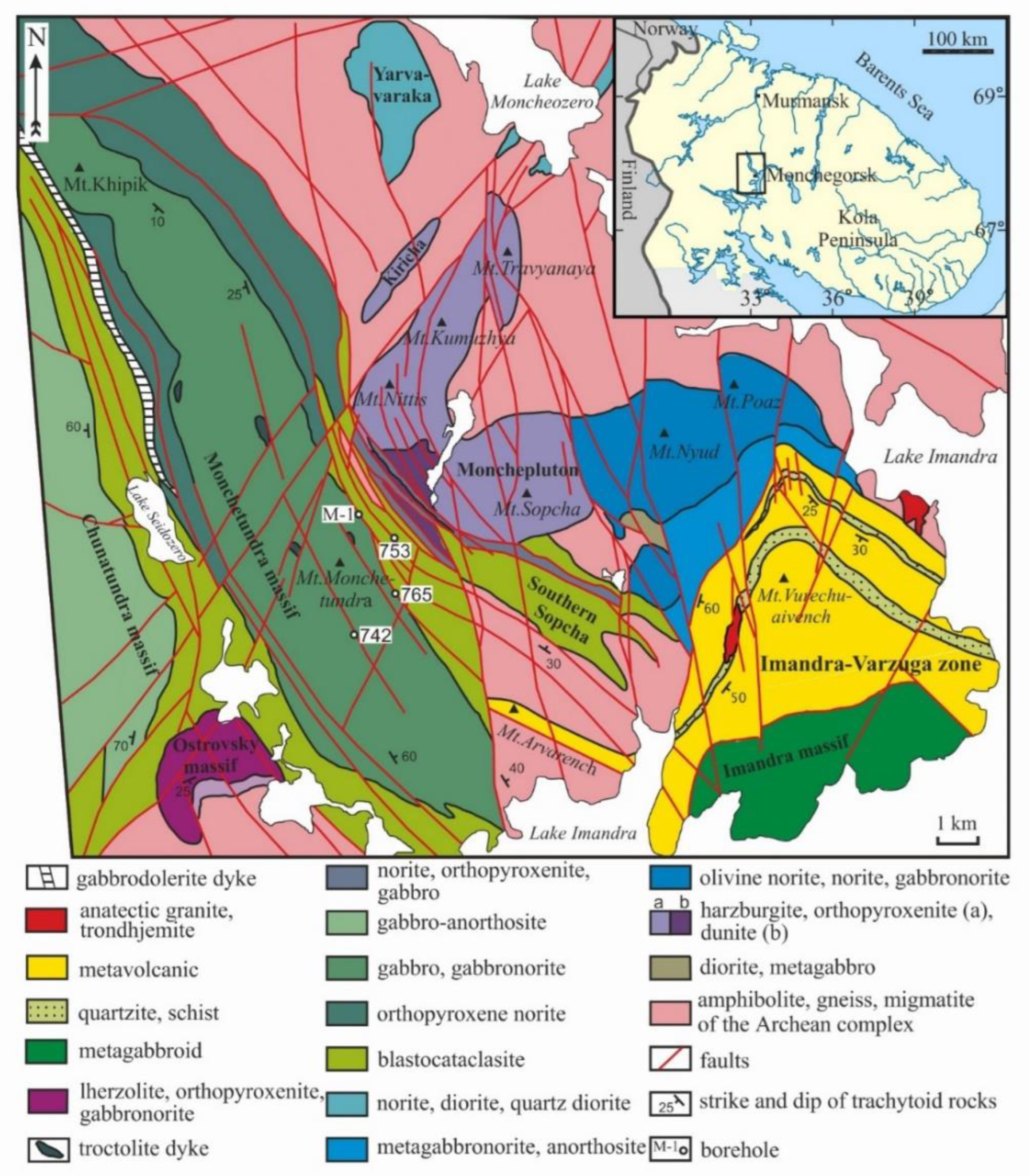
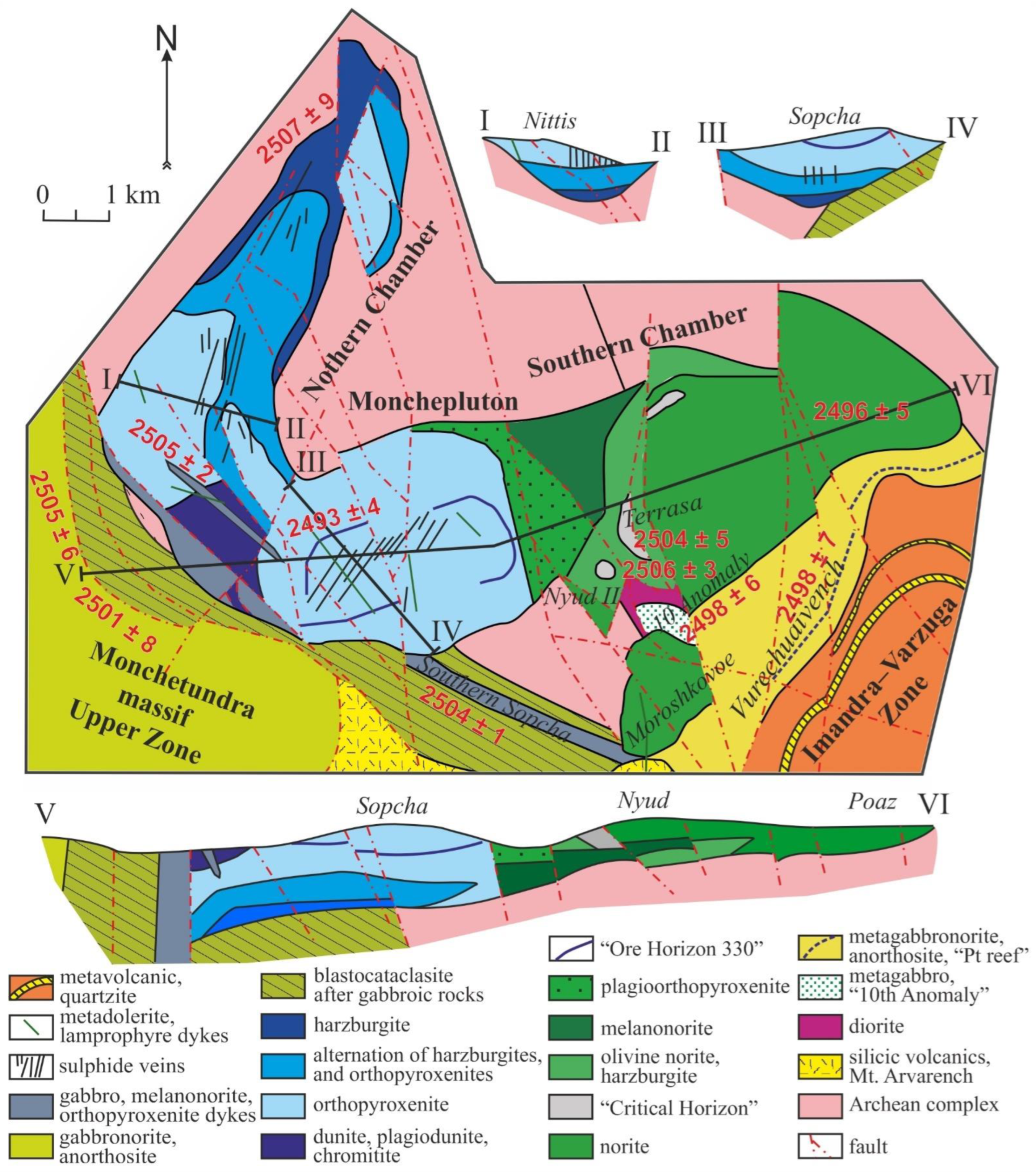


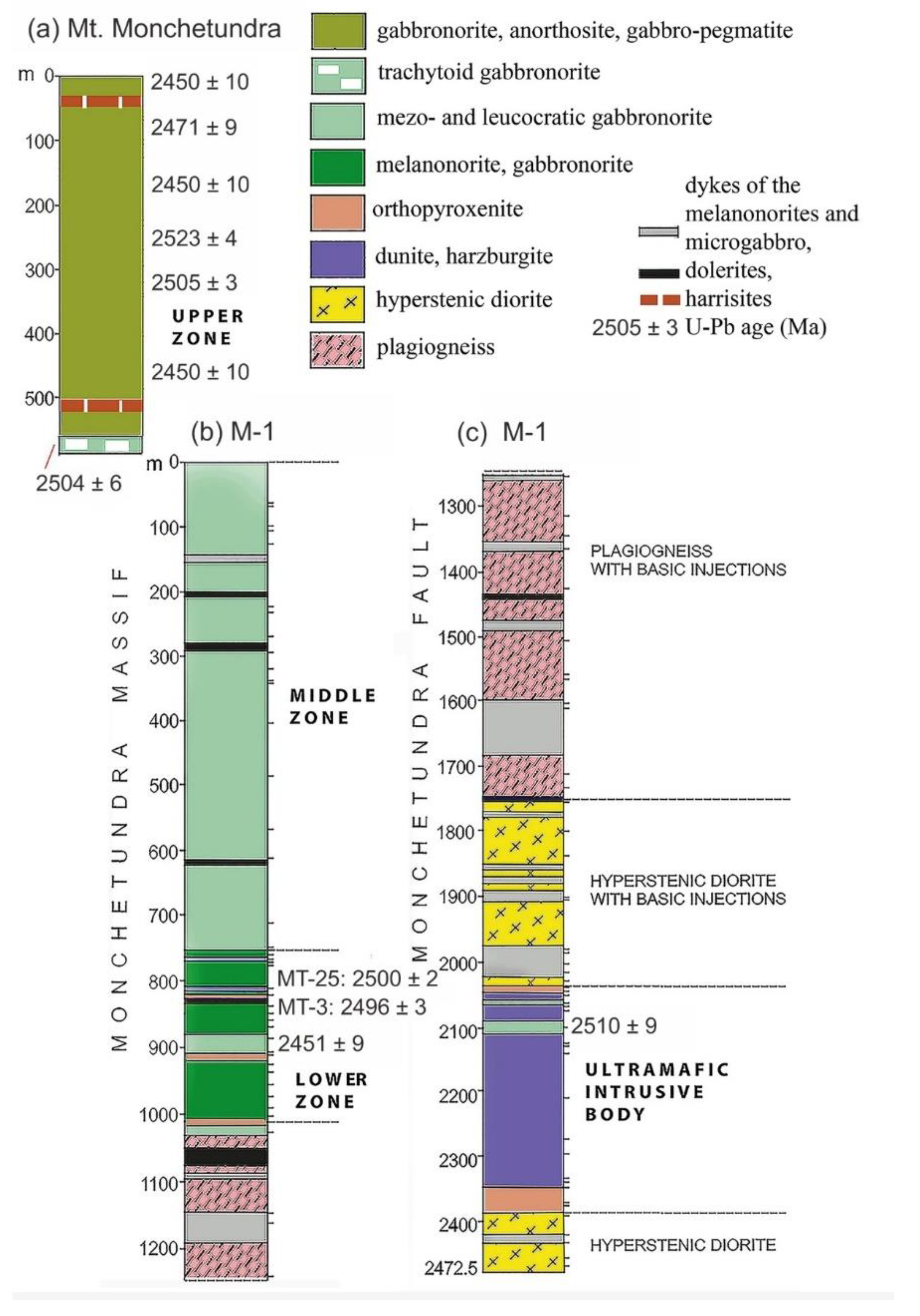
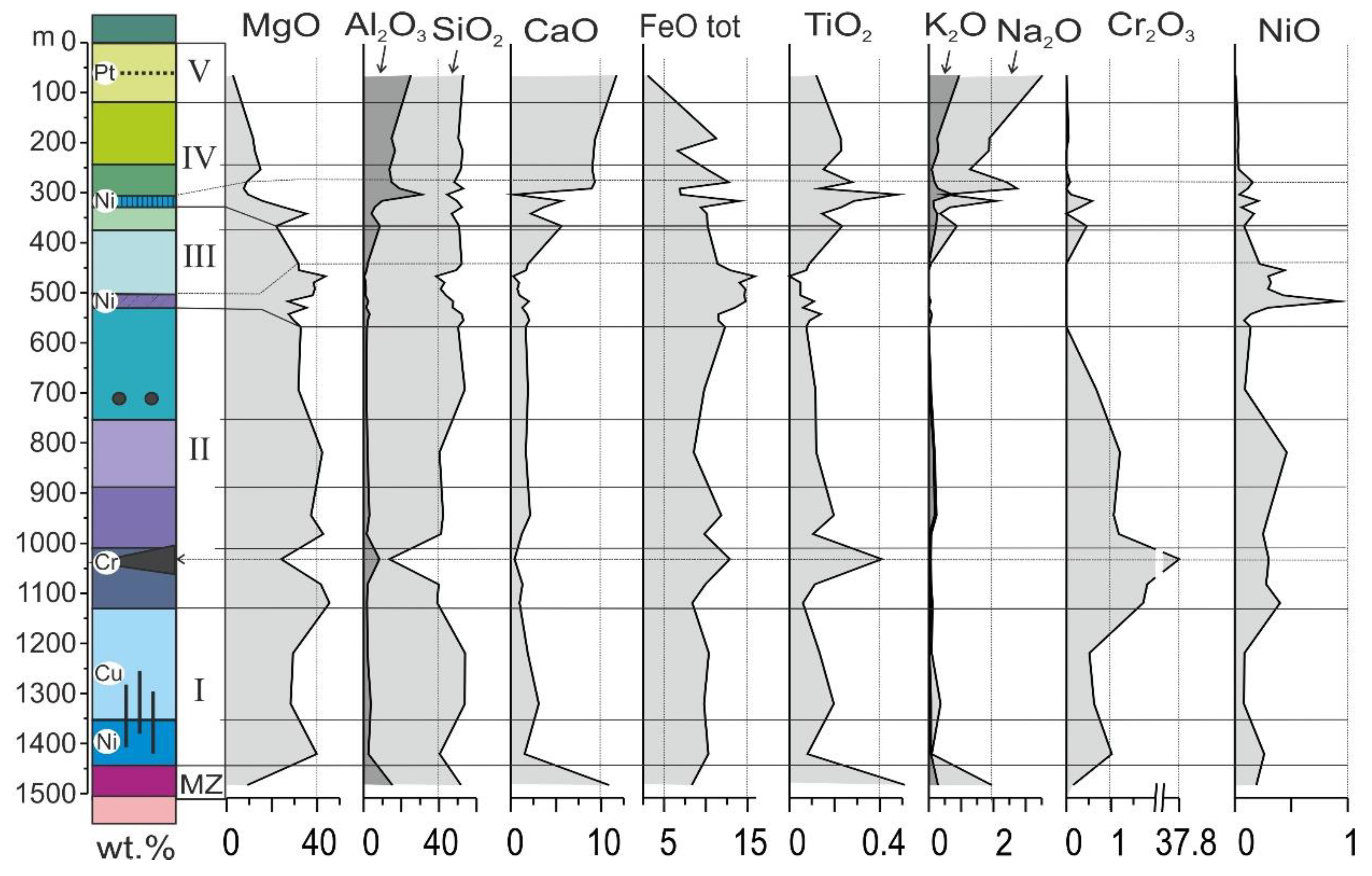

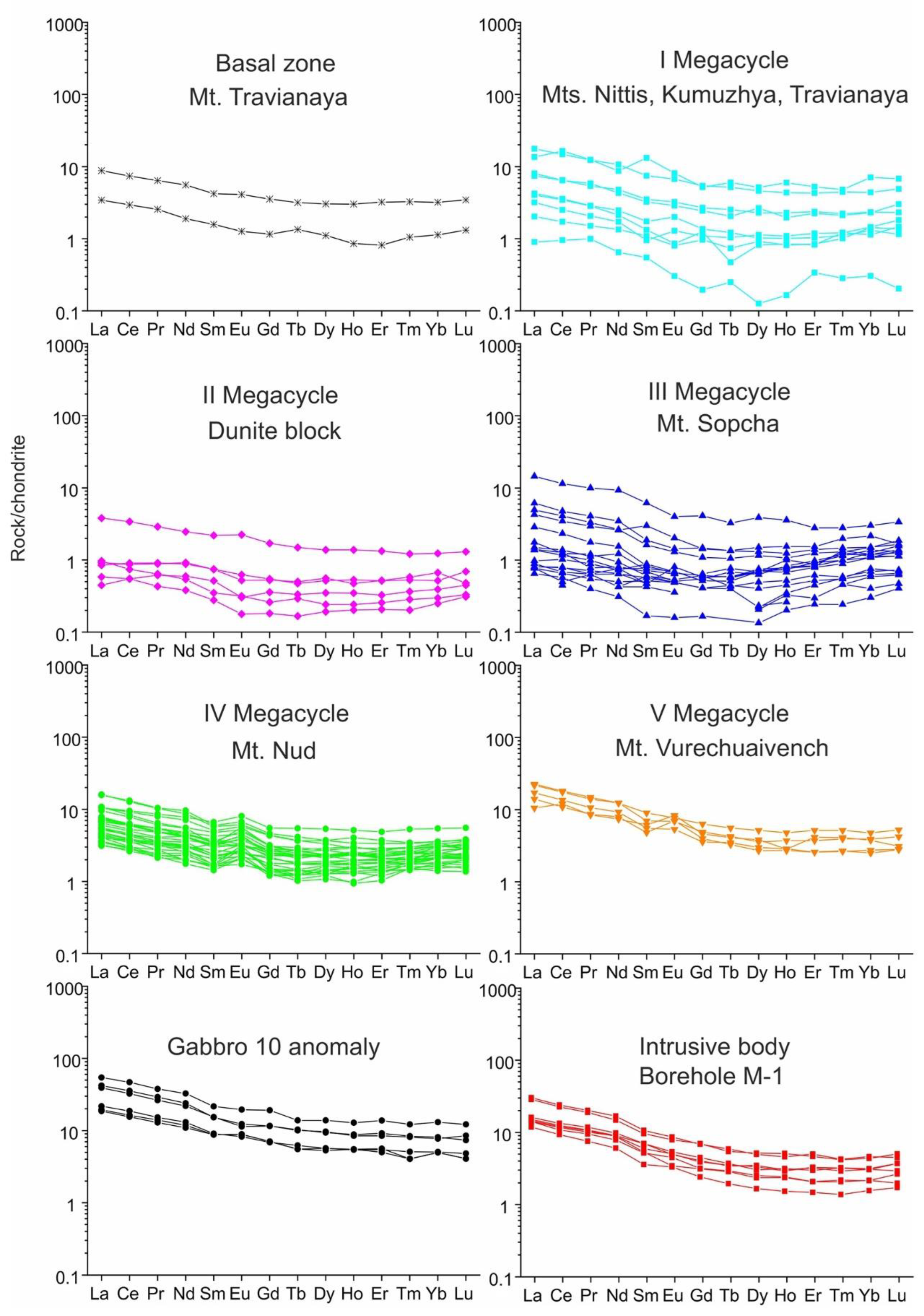
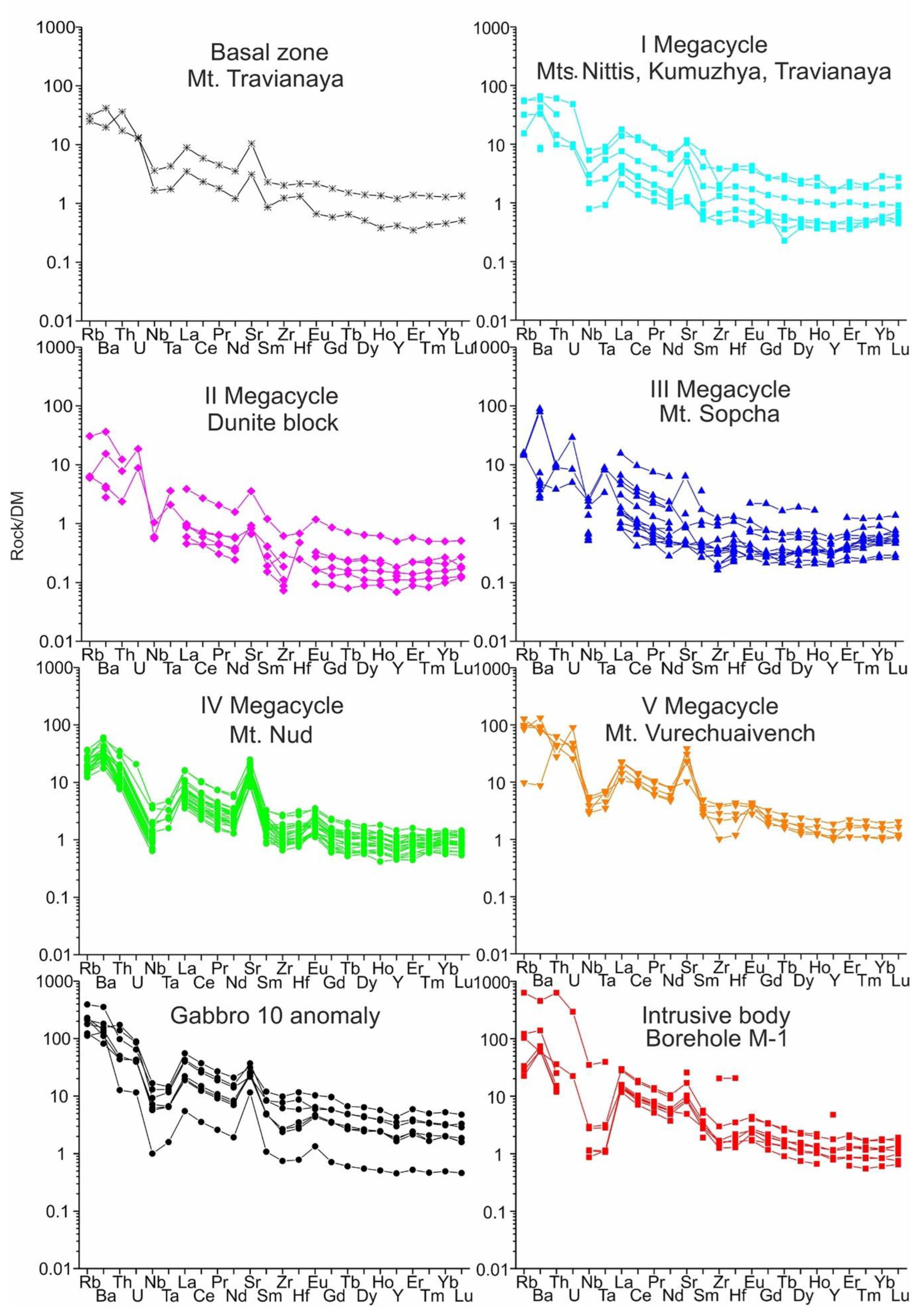

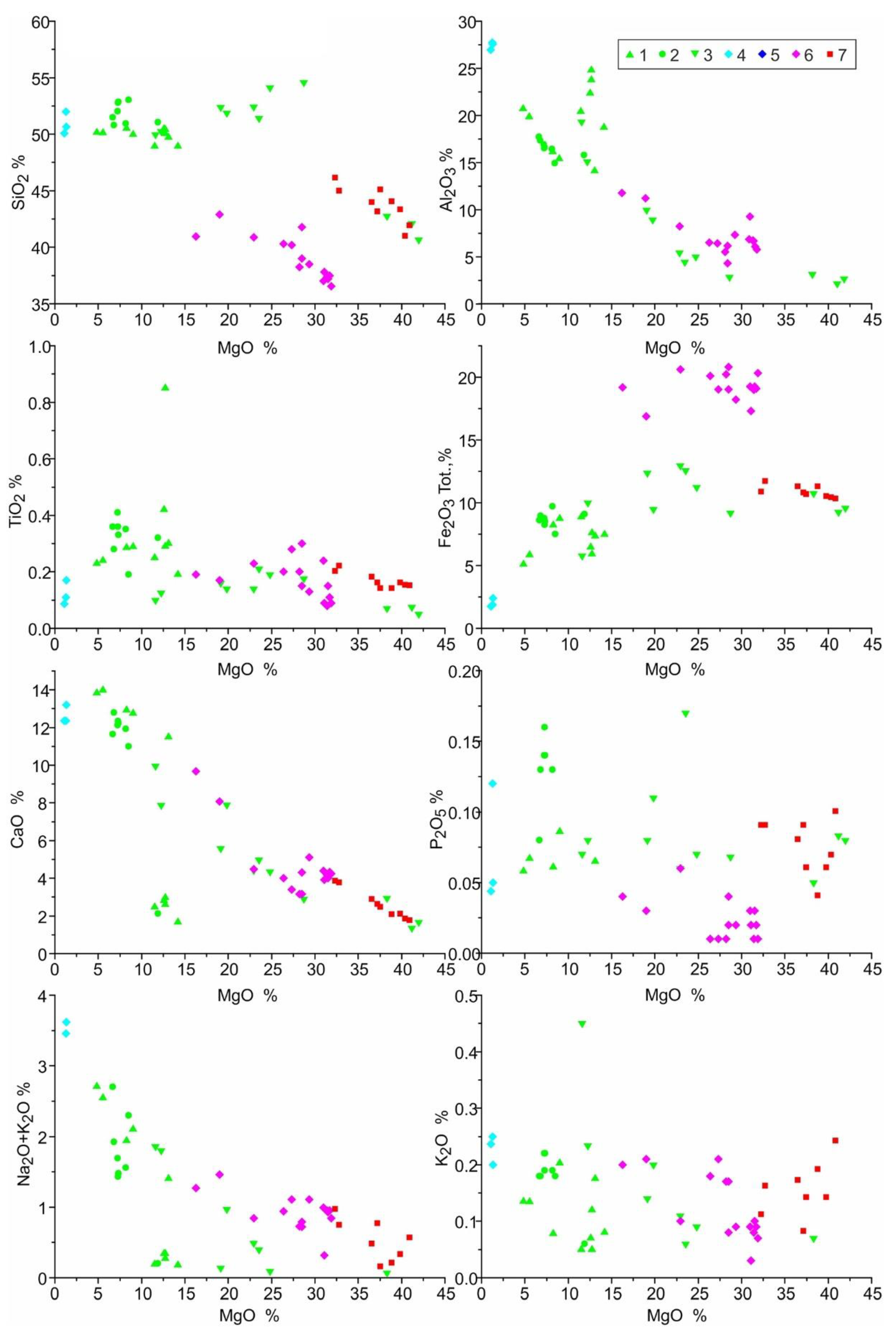
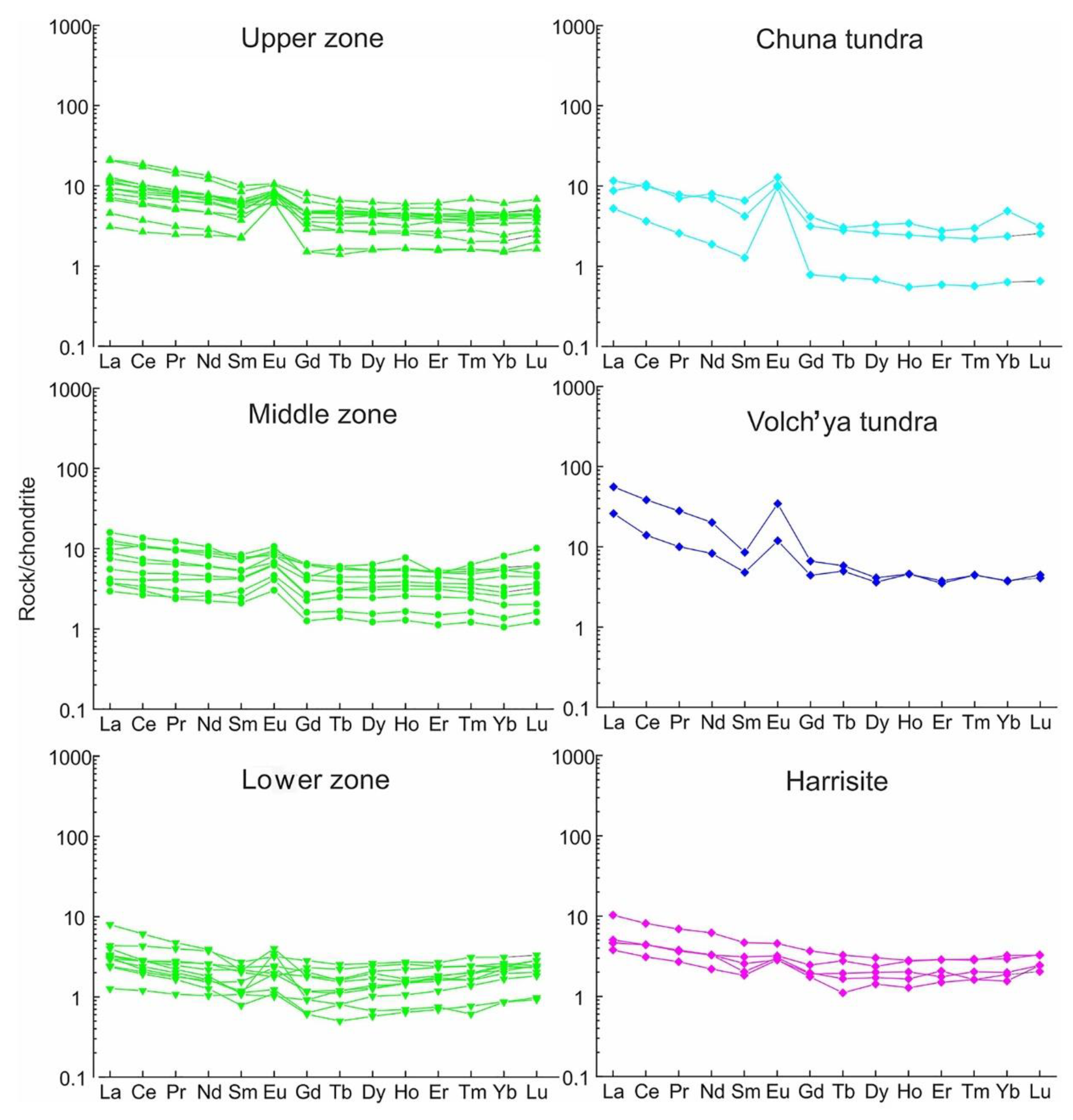



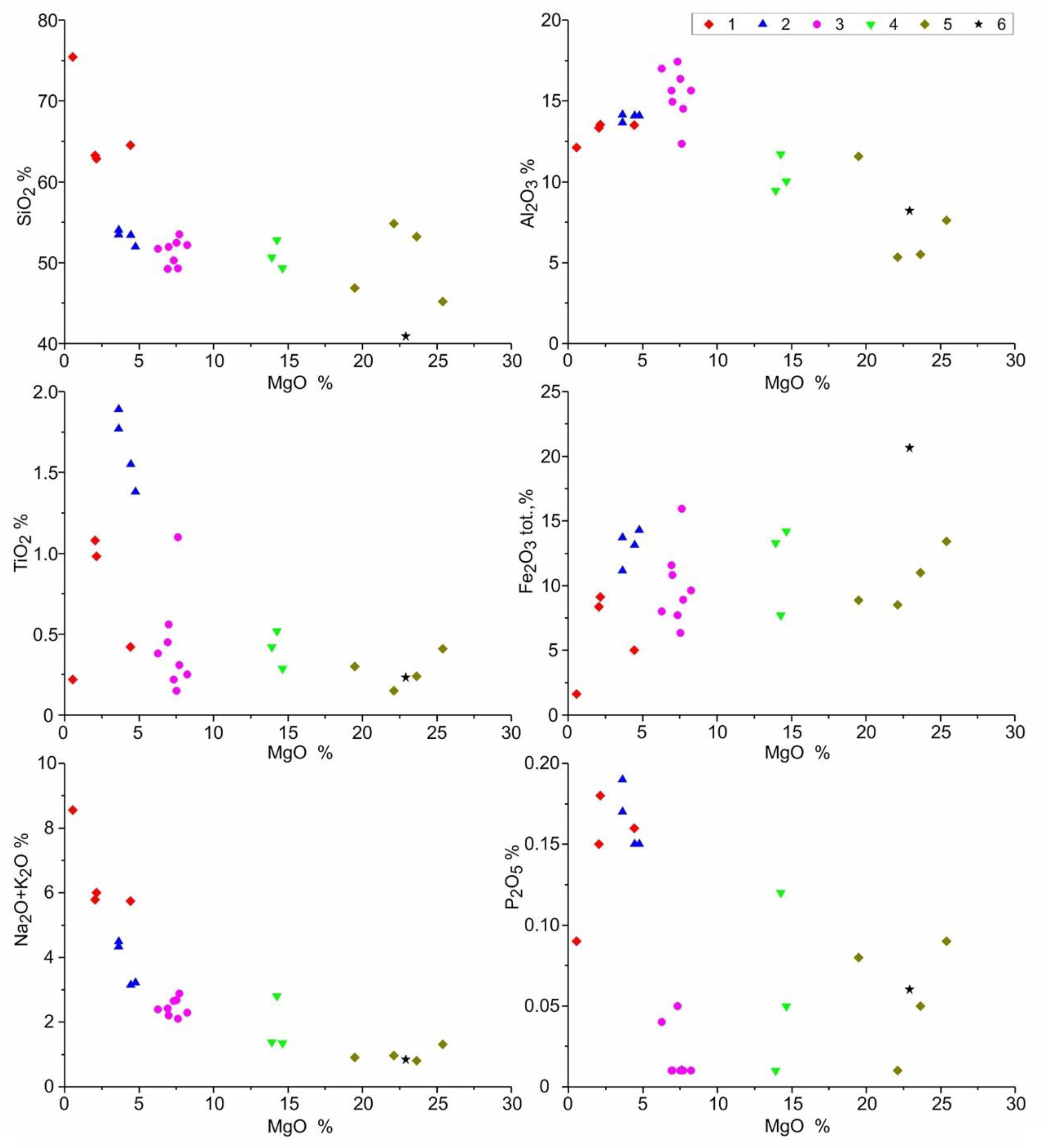
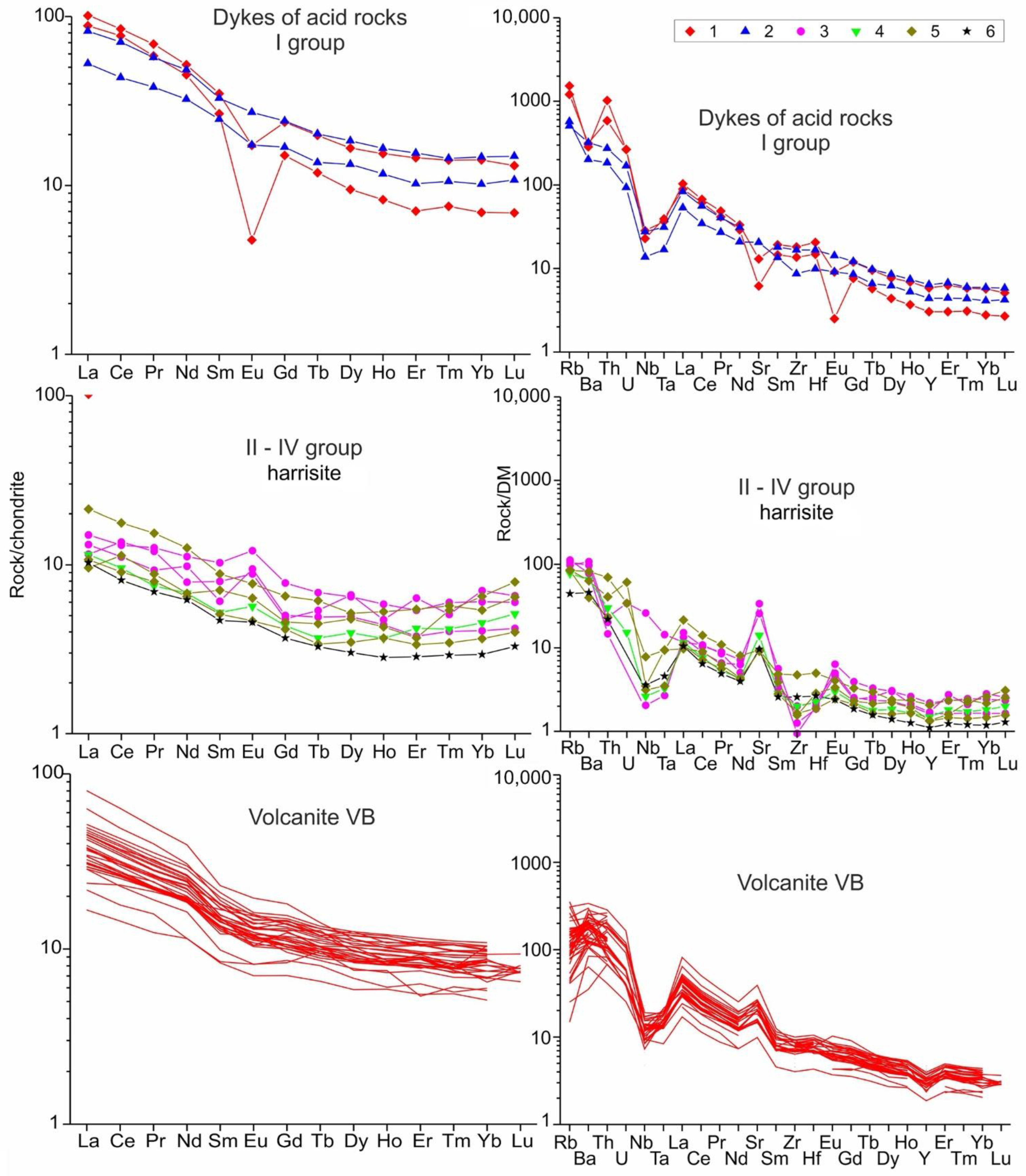
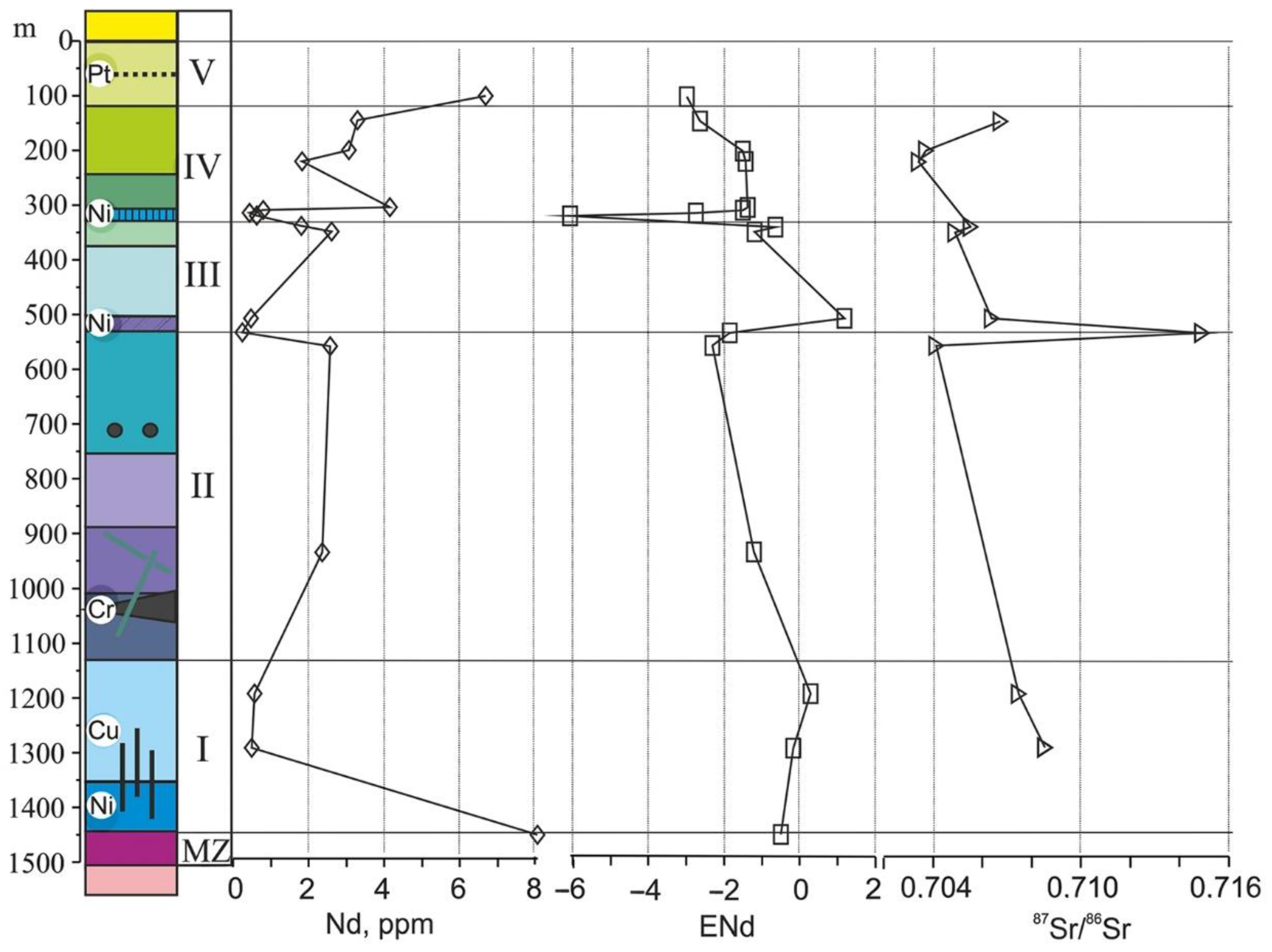
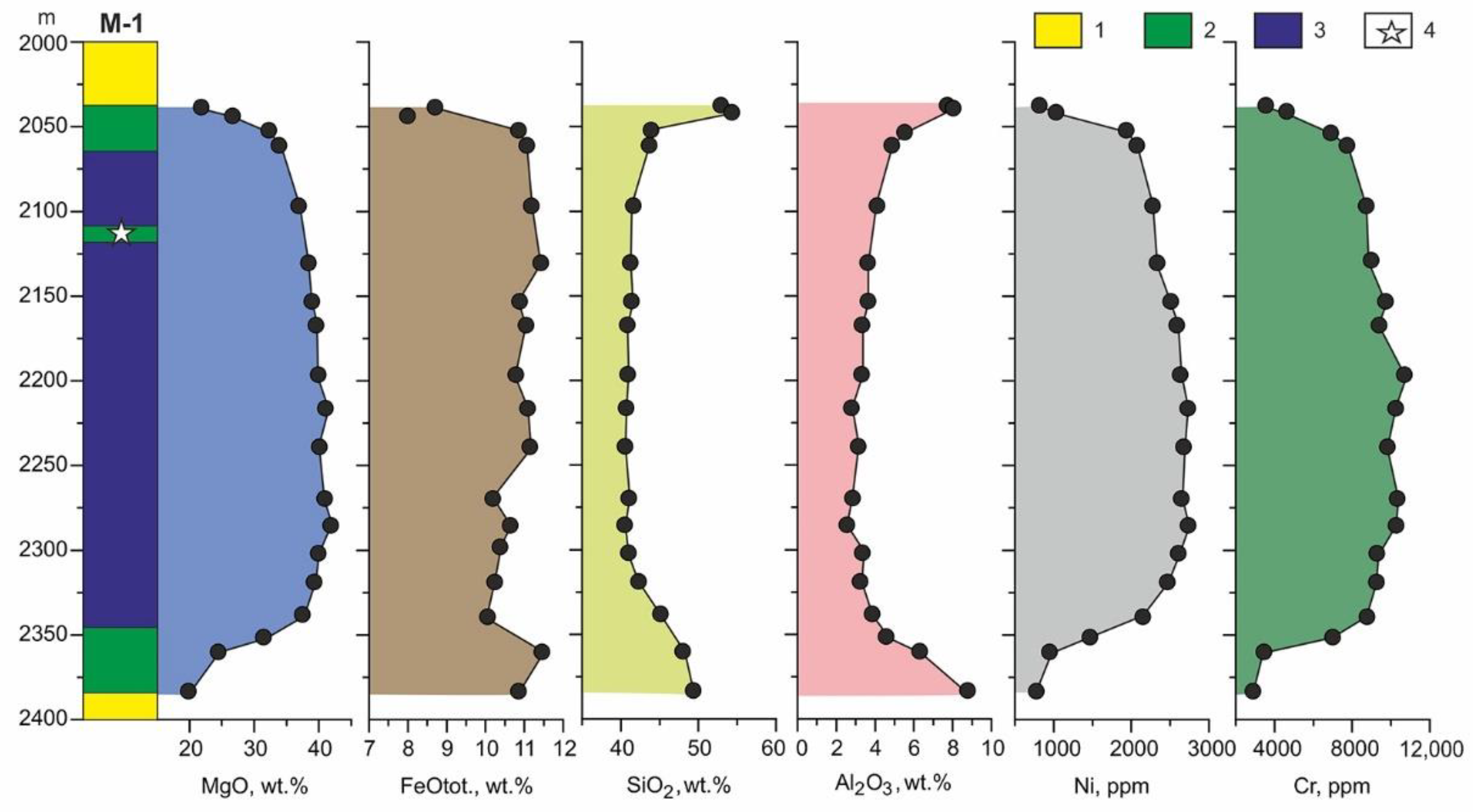
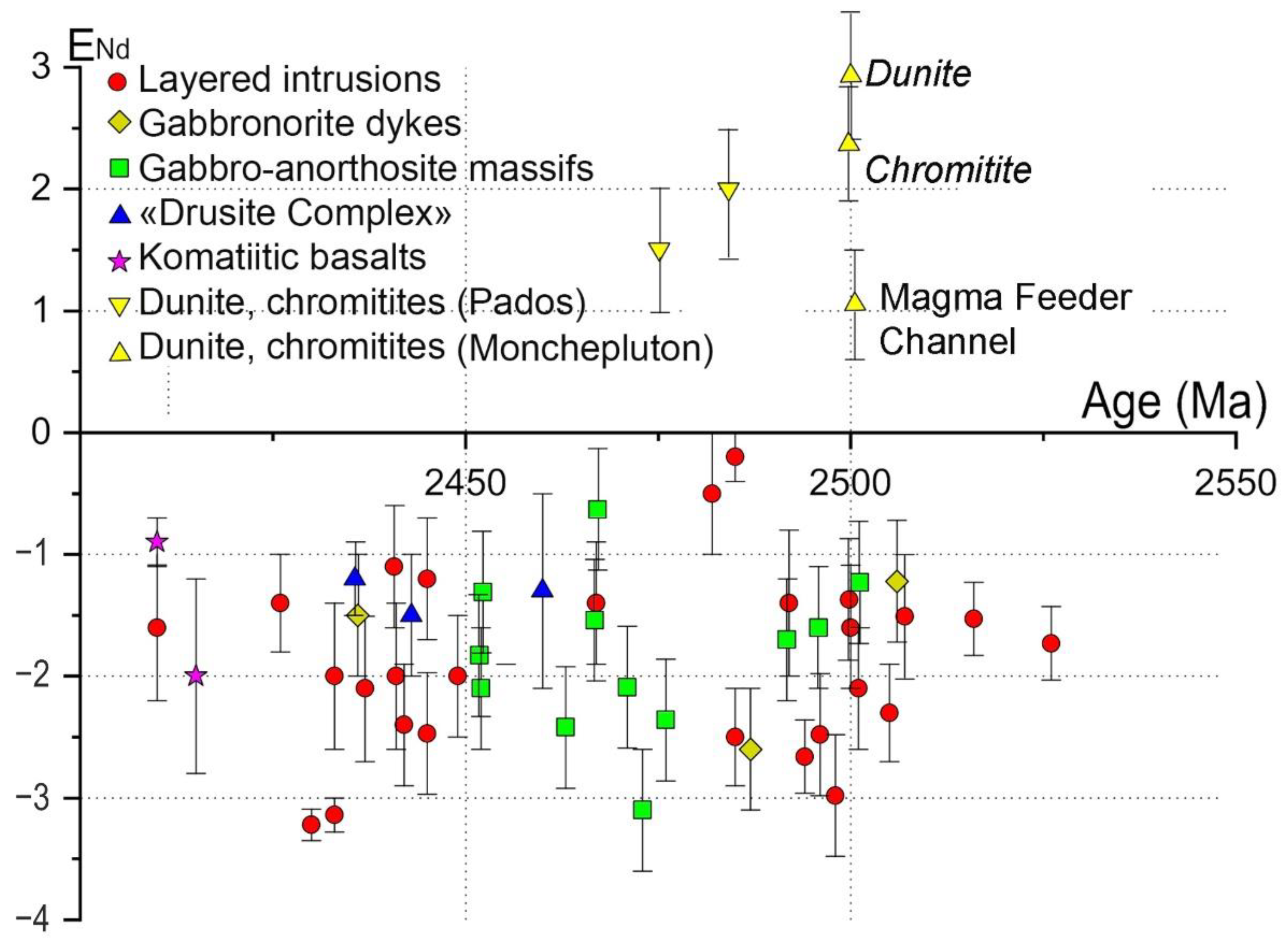
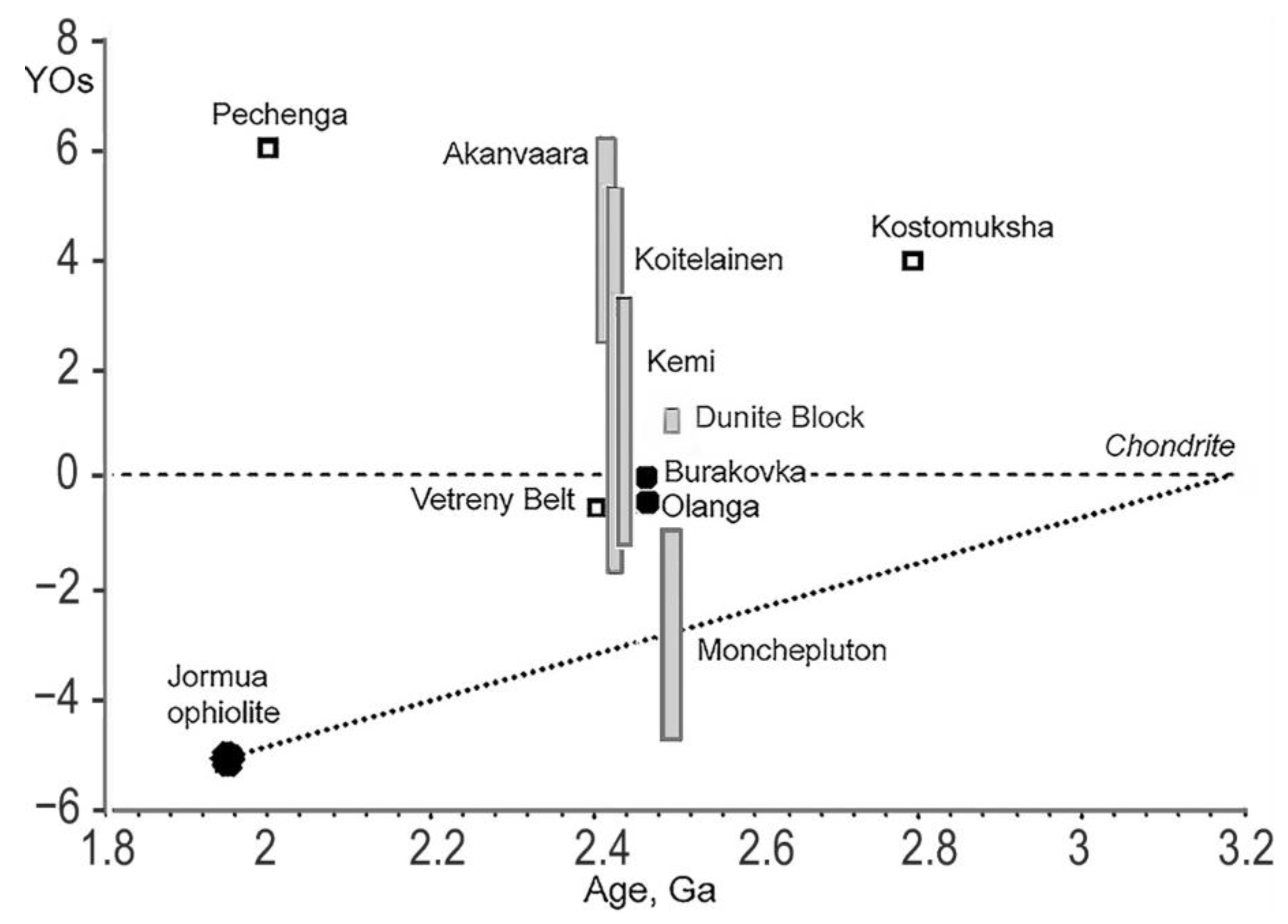
| No. Sample | M-12 | M-14 | M-61 | M-52 | 2066 |
|---|---|---|---|---|---|
| U–Pb age (Ma) | 2506 ± 10 | 2496 ± 14 | 2491 ± 9 | 2495 ± 13 | 2455 ± 10 |
| SiO2 | 52.44 | 54.85 | 52.81 | 64.53 | 40.89 |
| TiO2 | 0.15 | 0.15 | 0.52 | 0.42 | 0.23 |
| Al2O3 | 16.36 | 5.33 | 11.72 | 13.51 | 8.21 |
| Fe2O3 | 2.38 | 1.24 | 1.01 | 1.07 | 20.63 |
| FeO | 4.77 | 8.31 | 7.68 | 4.56 | - |
| MnO | 0.13 | 0.18 | 0.13 | 0.08 | 0.26 |
| MgO | 7.48 | 22.13 | 14.25 | 4.40 | 22.94 |
| CaO | 10.83 | 4.52 | 6.74 | 3.66 | 4.49 |
| Na2O | 2.39 | 0.75 | 1.90 | 2.97 | 0.74 |
| K2O | 0.3 | 0.21 | 0.92 | 2.78 | 0.10 |
| H2O- | 0.56 | 0.56 | 0.20 | 0.11 | - |
| H2O+ | 1.59 | 1.33 | 1.17 | 1.79 | 1.29 |
| P2O5 | 0.01 | 0.01 | 0.12 | 0.16 | 0.06 |
| CO2 | 0.15 | 0.1 | 0.43 | 0.44 | 0.43 |
| S | 0.02 | 0.01 | 0.20 | 0.07 | 0.20 |
| F | 0.009 | 0.009 | 0.027 | 0.065 | 0.027 |
| Cl | 0.020 | 0.035 | 0.004 | 0.006 | 0.004 |
| Total (wt.%) | 99.59 | 99.72 | 99.83 | 100.62 | 99.84 |
| Cu, ppm | 120 | 52 | 60 | 99 | 60 |
| Ni, ppm | 180 | 590 | 600 | 280 | 632 |
| Co, ppm | 39 | 69 | 50 | 29 | 164 |
| Cr, ppm | 26 | 2100 | 2300 | 770 | 36 |
| V, ppm | 140 | 120 | 130 | 110 | 67 |
| Methods | ID-TIMS * [7] | ID-TIMS * [6,10] | ID-TIMS ** [9] | SIMS-SHRIMP II [20,21] |
|---|---|---|---|---|
| Gabbronorite–pegmatite, “Critical Horizon”, Mt. Nyud, IV Megacycle | 2504.4 ± 1.5 (Zr) | M-2: 2505 ± 5 (Zr) | M-2: 2503.5 ± 4.6 (Zr) | M-64: 2500 ± 11 (Zr) |
| Metagabbronorite, Pt-reef, Mt. Vurechuaivench, V Megacycle | M-42: 2497 ± 21 (Zr + Bd) | M-42: 2498 ± 6.7 (Bd) | ||
| Gabbronorite, Monchetundra massif, the bottom of the Upper Zone | M-6, M-54: 2501 ± 8 (Zr) M-55: 2505 ± 6 (Zr) | M-55: 2504 ± 7.4 (Zr) | M-55: 2494.6 ± 7.3 (Zr) 1841 ± 25 (Zr1) | |
| Gabbronorite, dyke, the Olenegorsk quarry | M-52: 2495 ± 13 (Bd) | M-61: 2490.5 ± 8.9 (Bd) |
| N Analysis, Olivine * | N Analysis, Cr-Spinel * | T, °C | dlogfO2 (QFM) ** |
|---|---|---|---|
| M-1/2059,5-2 | M-1/2059,5-2 | 1103 | +2.6 |
| M-1/2072,0-1-5 | M-1/2072,0-1-12 | 1119 | +1.9 |
| M-1/2132-1 | M-1/2132-1c | 1222 | +2.2 |
| M-1/2132-2 | M-1/2132-1c | 1217 | +2.3 |
| M-1/2338-1 | M-1/2338-1 | 1221 | +1.8 |
| M-1/2338-2 | M-1/2338-1 | 1197 | +1.9 |
Publisher’s Note: MDPI stays neutral with regard to jurisdictional claims in published maps and institutional affiliations. |
© 2022 by the authors. Licensee MDPI, Basel, Switzerland. This article is an open access article distributed under the terms and conditions of the Creative Commons Attribution (CC BY) license (https://creativecommons.org/licenses/by/4.0/).
Share and Cite
Smol’kin, V.F.; Mokrushin, A.V. Paleoproterozoic Layered Intrusions of the Monchegorsk Ore District: Geochemistry and U–Pb, Sm–Nd, Re–Os Isotope Analysis. Minerals 2022, 12, 1432. https://doi.org/10.3390/min12111432
Smol’kin VF, Mokrushin AV. Paleoproterozoic Layered Intrusions of the Monchegorsk Ore District: Geochemistry and U–Pb, Sm–Nd, Re–Os Isotope Analysis. Minerals. 2022; 12(11):1432. https://doi.org/10.3390/min12111432
Chicago/Turabian StyleSmol’kin, Valery F., and Artem V. Mokrushin. 2022. "Paleoproterozoic Layered Intrusions of the Monchegorsk Ore District: Geochemistry and U–Pb, Sm–Nd, Re–Os Isotope Analysis" Minerals 12, no. 11: 1432. https://doi.org/10.3390/min12111432
APA StyleSmol’kin, V. F., & Mokrushin, A. V. (2022). Paleoproterozoic Layered Intrusions of the Monchegorsk Ore District: Geochemistry and U–Pb, Sm–Nd, Re–Os Isotope Analysis. Minerals, 12(11), 1432. https://doi.org/10.3390/min12111432






